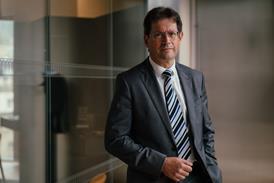On 12 September 1962, president John F. Kennedy declared that the United States 'should commit itself to achieving the goal, before this decade is out, of landing a man on the Moon and returning him safely to the Earth'. Within nine years, that goal was achieved. Those of us who lived through those years, even as small children, absorbed at least something of the age’s ‘can do’ faith in technology. Even though it was typically expressed in questions like 'If they can land on the Moon, why can’t they run the 8:15 to Blackfriars?'.
Now veteran legal technology guru professor Richard Susskind - a junior member of the Apollo generation - is proposing a moonshot in law. Or rather, two moonshots. At an event organised by the lobby group LegalUK earlier this month, Susskind proposed the establishment of a National Institute for Legal Innovation to tackle twin challenges: access to justice and assuring the future of England and Wales common law as the international commercial jurisdiction of choice.
The institute would systematically bring together the best legal minds and experts in new technology, especially the fast-moving area of artificial intelligence, he said. It would have five areas of work: 'horizon scanning', testing prototypes of lawtech innovations, research, attracting ‘world class thought leaders’ and training the next generation of legal professionals in innovation.
Its establishment would take over and broaden the work of the current LawtechUK initiative, which is coming to the end of its government funding. The current second phase of the programme, run by CodeBase and Legal Geek, will run down in March 2025. Its demise, Susskind said, will be ‘no national statement about the future of these sectors’.
Susskind did not suggest where the institute might be based, or go into much detail about its funding beyond suggesting a mixture of public and private.
Certainly national leadership is needed in both of Susskind's challenges. Whether this is best achieved by a single new institute is another matter. To consider this call we might look back at the international history of setting up centres of excellence in innovation. We have many successful examples, from the wartime Bletchley Park and Los Alamos to Xerox PARC and IBM Research Zurich and the Laboratory of Molecular Biology at Cambridge. To those, we hope, history will add the newly established Francis Crick Institute and the Alan Turing Institute.
We also have failures: Japan's Institute of New Generation Computer Technology, was born in the 1980s to develop a 'fifth generation' of computers, triggering near panic in Europe and the US, but failed to achieve much of lasting significance. (Looking back, we can say that, while it had good ideas about the potential of so-called neural networks, it failed to realise that the breakthrough would depend on the availability of massive amounts of training data.)
To this could be added numerous 'science parks' attached to second-rate academic establishments. Most embarrassing are the attempts by moribund institutions to emulate what they think are the hallmarks of creative culture. I'll spare the blushes of the UK government body which read about bright ideas emerging from garden sheds - and so installed a garden shelf on one of the floors of its brutal 1960s office block. Or the Japanese electronics giant which, in order to inject a bit of Silicon Valley culture, decreed that its researchers would be allowed to come to work in jeans. Sure enough, on the day of my visit, every single member of staff was in identical, beautifully pressed dark blue jeans.
It may be that three things are necessary - though perhaps not sufficient - to the creation of a world beating research institution. One is a defined purpose, for example to beat the Nazis to the atomic bomb. The second is to be working in an area of science where the prospect of being part of a paradigm-shifting breakthrough will attract the brightest and the best. An example here was Cambridge's cracking of the genetic code. The final one, of course, is money. It can't buy you Nobel prizes, but it gets things done: the Apollo Moon programme consumed some 2.5% of the US's entire GDP for a decade.
Our proposed national institute seems to tick two of the three boxes. It is certainly working in a paradigm-shifting area of technology: Susskind likes to quote the statistic that the performance of neural networks (the technology that underlies most current AI systems) is currently doubling every 3.5 months. We literally have no idea where this will take us.
Funding, meanwhile, may not be an insuperable problem now that national science and technology policies are back in fashion. For current thinking on the right, read an interesting new Policy Exchange paper in which Conservative former minister Lord Willetts looks back at the technology winners he picked a decade ago. 'Technology foresight exercises are not hopeless in the face of radical uncertainty,' he concludes. As for the left, surely space can be found for justice innovation in the manifesto of a new(ish) Labour Party?
The biggest problem confronting Susskind's proposed institute may be its dual aims. Counter-intuitively, these may present a tougher job than the Moonshot did in 1962. Apollo was a triumph of engineering and project management, not to mention human courage, but we knew in 1962 where the Moon would be in 1969. Indeed the goal was picked because it was the most spectacular achievable one with which the US could beat the Soviet Union, which in 1962 was still apparently ahead in the 'space race'.
By contrast, 'access to justice' is a vague concept, with no finishing line - unless we adopt something akin to the World Health Organisation's old mantra of 'health for all by the year 2000'. (No prizes for guessing how that went.) An internationally usable common law 'platform' is an even more ephemeral idea. No one - I suspect not even the master of the rolls, incidentally another child of the Apollo years - has any idea what it will look like or how we will go about developing it. Perhaps it is supposed to emerge in true common-law fashion from the work on access to justice? But at the moment it is hard to see how.
But back to Kennedy. In his historic speech he said: 'We choose to go to the Moon in this decade and do the other things, not because they are easy, but because they are hard; because that goal will serve to organize and measure the best of our energies and skills.’
That's not a bad reason to consider a National Institute for Legal Innovation.



































2 Readers' comments